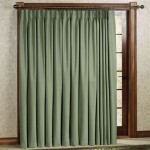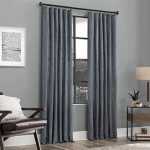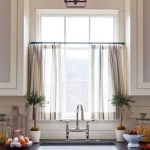Should Window Curtains Touch the Floor? Exploring Length and Aesthetics
The question of whether window curtains should touch the floor is a recurring theme in interior design discussions. The answer is not a simple yes or no, as it depends on a multitude of factors, including the overall style of the room, the type of fabric used for the curtains, and the practical needs of the space. Understanding the various options and their implications can equip homeowners with the knowledge to make informed decisions regarding their window treatments.
Properly hung curtains can significantly enhance a room's perceived height, create a sense of elegance, and contribute to the overall ambiance. Conversely, incorrectly sized or hung curtains can detract from the room's aesthetic appeal and even create a visually jarring effect. Therefore, careful consideration of curtain length and placement is paramount when designing or updating a living space.
Understanding the Three Primary Curtain Length Options
There are three main options when determining the length of window curtains: floating, breaking, and pooling. Each option offers a distinct visual effect, and the choice should be made based on the desired aesthetic and the function of the room. Understanding the nuances of each length is critical to achieving the desired outcome.
Floating Curtains: Floating curtains hang just above the floor, typically around half an inch to an inch. This option offers a clean, modern look and is often preferred in high-traffic areas or homes with pets, as it minimizes the build-up of dust and dirt. The slight gap between the curtain and the floor also facilitates easy cleaning and movement. From a practical standpoint, floating curtains are less likely to be tripped over or snagged, making them a safer option for households with children or elderly individuals. Furthermore, this length prevents the curtains from absorbing moisture from damp floors, which can lead to mold and mildew growth over time.
Breaking Curtains: Breaking curtains, also known as "kissing" the floor, gently touch the floor with a slight break in the fabric. This is a popular choice, offering a balance between the clean lines of floating curtains and the more dramatic effect of pooling curtains. The subtle break creates a relaxed yet sophisticated look. The "break" refers to the slight bend or fold in the fabric where it meets the floor. This style works well with most fabric types and adds a touch of softness to the room. While it offers a slightly more formal appearance than floating curtains, it is still relatively practical and easy to maintain.
Pooling Curtains: Pooling curtains extend several inches onto the floor, creating a luxurious and dramatic effect. This style is best suited for formal spaces, such as living rooms or bedrooms, and is often used to add a touch of opulence. Pooling curtains can create a romantic and elegant atmosphere, but they require more maintenance than the other two options. The excess fabric on the floor can accumulate dust and dirt, and it is more susceptible to snagging and damage. Pooling curtains are also not ideal for high-traffic areas or homes with pets, as they can easily become dirty or tangled. However, when used appropriately, pooling curtains can significantly enhance the visual appeal of a room.
Factors Influencing the Decision: Style, Fabric, and Function
The choice of curtain length should not be made in isolation. Several factors need to be considered to ensure that the chosen length complements the room's style, the fabric of the curtains, and the intended function of the space. These factors work in concert to determine the optimal curtain length for a given room.
Style of the Room: The overall style of the room is a crucial determinant of the appropriate curtain length. In modern or minimalist spaces, floating curtains are often preferred for their clean lines and understated elegance. In more traditional or formal spaces, breaking or pooling curtains can be used to add a touch of grandeur and sophistication. For example, a room with a contemporary aesthetic may benefit from the simplicity of floating curtains, while a room with a more classic or Victorian style might be enhanced by the drama of pooling curtains. The curtain length should complement the existing furniture, décor, and architectural features of the room to create a cohesive and harmonious design.
Type of Fabric: The type of fabric used for the curtains also plays a significant role in determining the appropriate length. Heavier fabrics, such as velvet or brocade, tend to pool more gracefully than lighter fabrics, such as linen or cotton. Lighter fabrics may look awkward if they are pooled too much, as they may not have the weight to drape properly. Conversely, heavier fabrics can create a luxurious and opulent effect when pooled. The texture and drape of the fabric should be considered carefully when determining the ideal curtain length. For instance, a lightweight linen curtain might look best when floating or slightly breaking, while a heavy velvet curtain could be stunning when pooled generously.
Function of the Room: The intended function of the room should also be taken into account. In high-traffic areas, such as hallways or entryways, floating curtains are generally the best option, as they are less likely to be tripped over or snagged. In bedrooms or living rooms, where aesthetics are often prioritized, breaking or pooling curtains may be more appropriate. In kitchens or bathrooms, where moisture is a concern, floating curtains are preferable to prevent mold and mildew growth. The practical needs of the space should always be considered when selecting curtain length. For example, in a child's bedroom, floating curtains are a safer option than pooling curtains, as they are less likely to be pulled down or played with.
Accurate Measurement and Installation for Optimal Results
Even with a clear understanding of the various options, the final result depends on accurate measurement and proper installation. Incorrectly measured or installed curtains can undermine the intended aesthetic and create a visually unappealing effect. Therefore, meticulous attention to detail is essential during the measurement and installation process.
Measuring for Curtain Length: Accurate measurement is the foundation of successful curtain installation. First, determine the desired height of the curtain rod. Ideally, the rod should be hung higher than the window frame to create the illusion of a taller window and a more spacious room. Then, measure from the top of the rod to the floor. For floating curtains, subtract half an inch to an inch from this measurement. For breaking curtains, add an inch or two. For pooling curtains, add several inches, depending on the desired amount of pooling. It is crucial to use a metal measuring tape for accuracy and to take multiple measurements to account for any variations in the floor level. Remember to also consider the type of curtain heading (e.g., grommets, rod pocket, pleats) when measuring, as this will affect the final length of the curtains.
Installing the Curtains: Proper installation is just as important as accurate measurement. Ensure that the curtain rod is securely mounted and level. Use appropriate hardware for the weight of the curtains and the type of wall. When hanging the curtains, ensure that they are evenly spaced and that the fabric drapes properly. For pleated curtains, take the time to arrange the pleats neatly. For grommet curtains, ensure that the grommets are evenly spaced on the rod. After hanging the curtains, step back and assess the overall appearance. Make any necessary adjustments to ensure that the curtains look their best. If using tiebacks or holdbacks, position them at a height that complements the curtain length and the overall style of the room.
In conclusion, there is no universally correct answer to the question of whether window curtains should touch the floor. The best option depends on a variety of factors, including the style of the room, the type of fabric used for the curtains, and the practical needs of the space. By carefully considering these factors and taking the time to measure and install the curtains properly, homeowners can achieve a visually appealing and functional window treatment that enhances the overall aesthetic of their home.

Should Curtains Touch The Floor Expert Tips Shade

Should Curtains Touch The Floor Expert Tips Shade

How Close To The Floor Should Your Drapes Hang Ask Expert Style Boston Com Real Estate

Should Curtains Touch The Floor Expert Tips Shade

Should Curtains Touch The Floor Expert Tips Shade

Should Curtains Touch The Floor Expert Tips Shade

When Should Curtains Touch The Floor Quickfit Blinds And

Curtain Length Dilemma To Touch Or Not The Ground F J Outdoors

Should Curtains Touch The Floor

Should Curtains Touch The Floor Answers To Common Curtain Questions Jarvis Interiors








